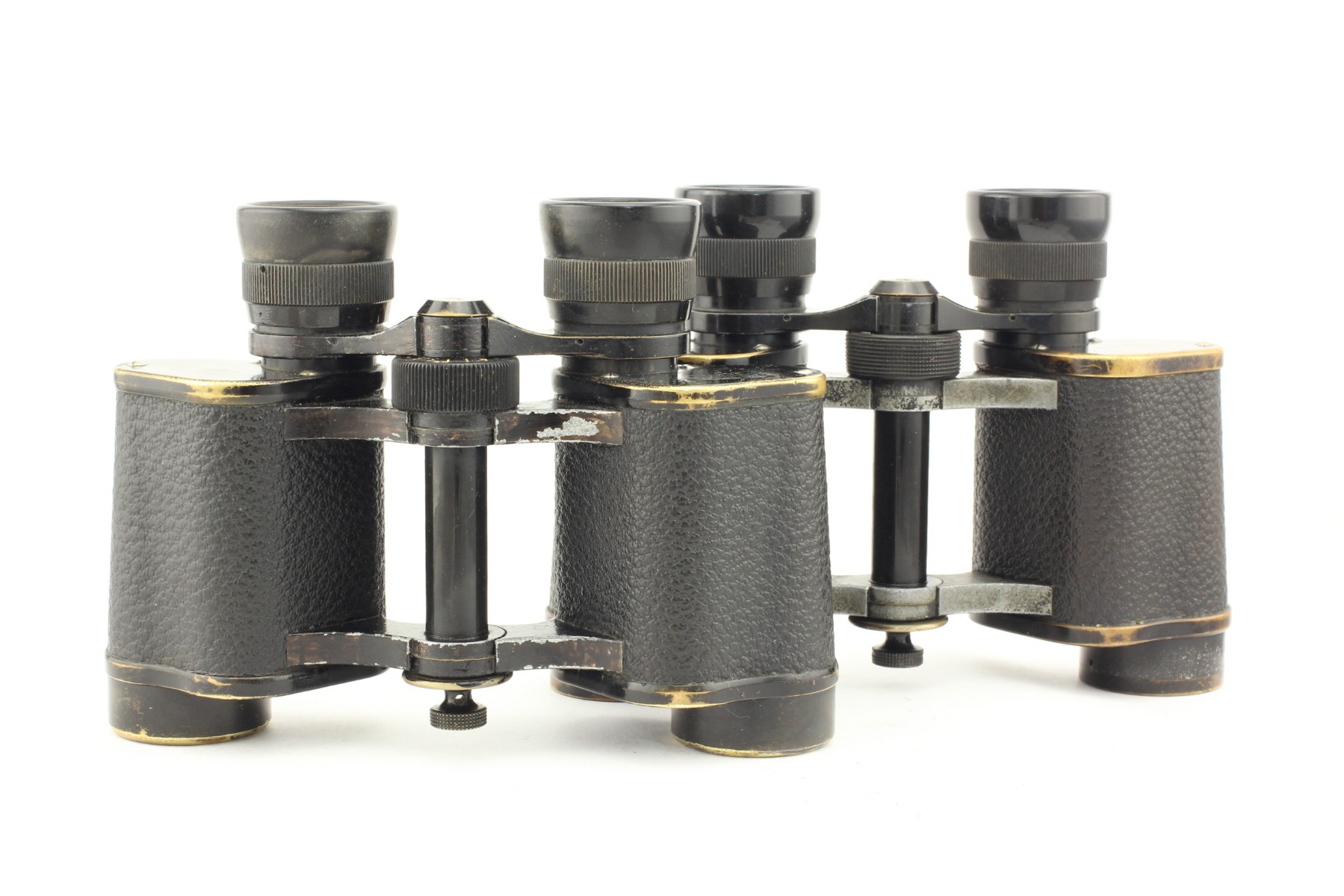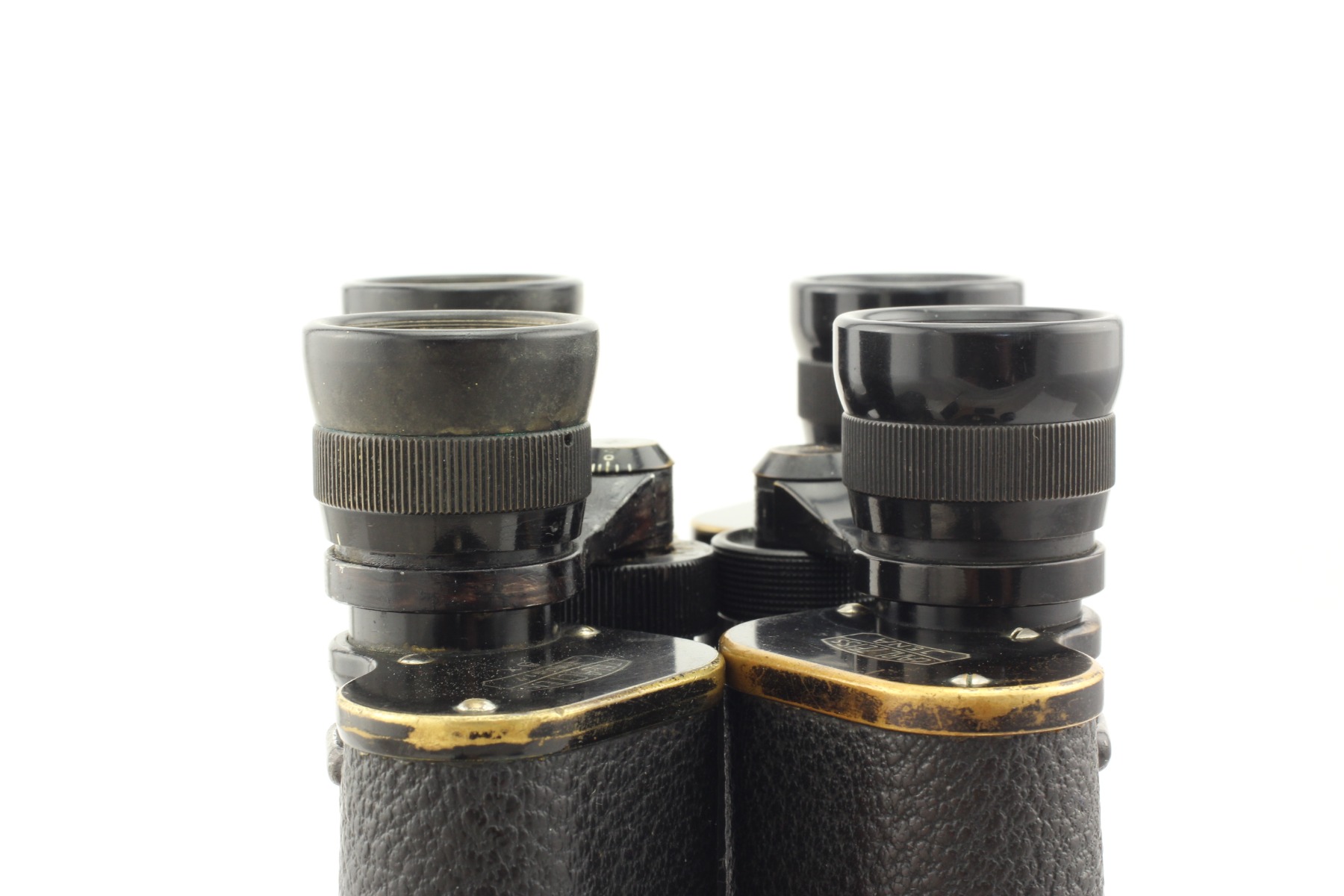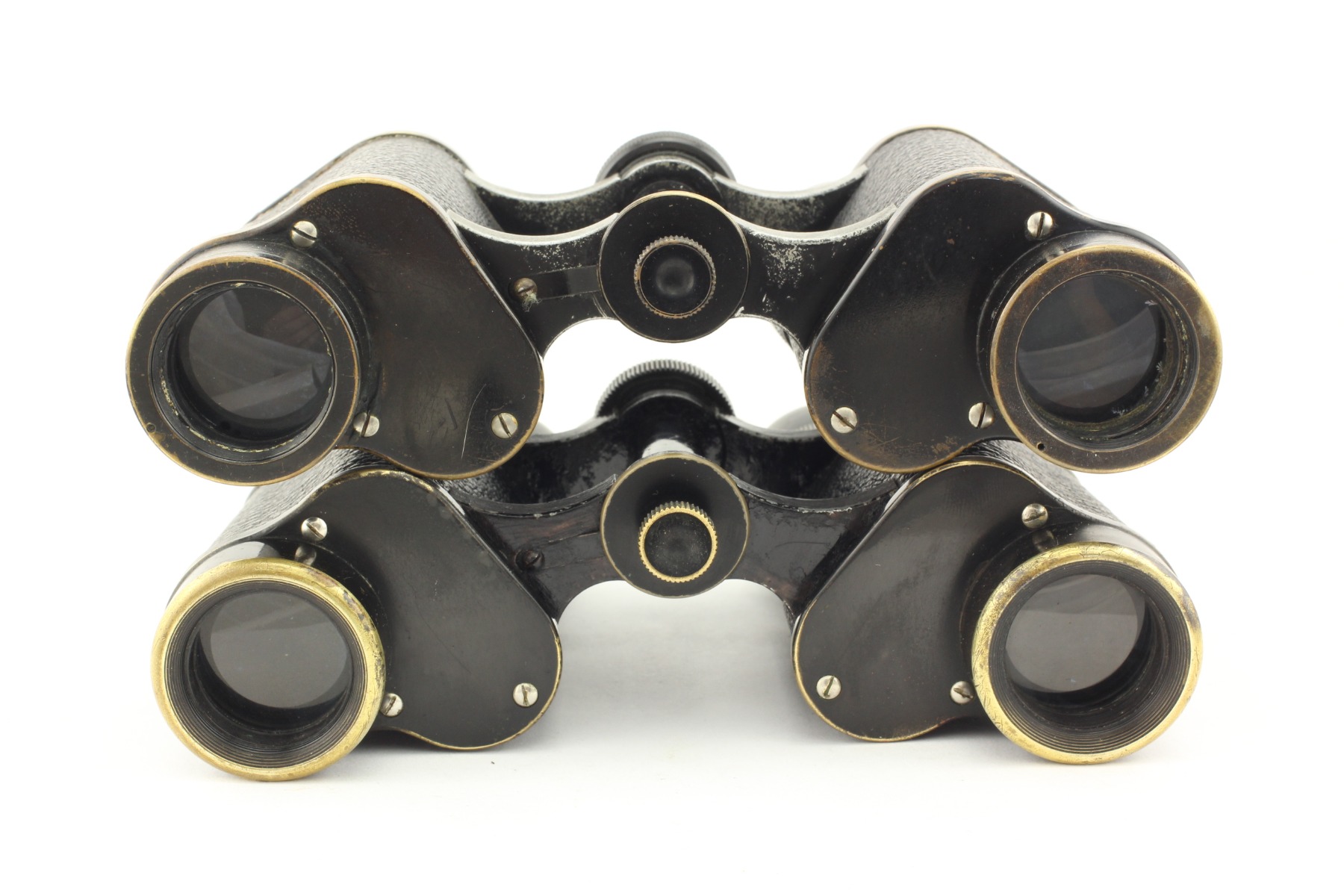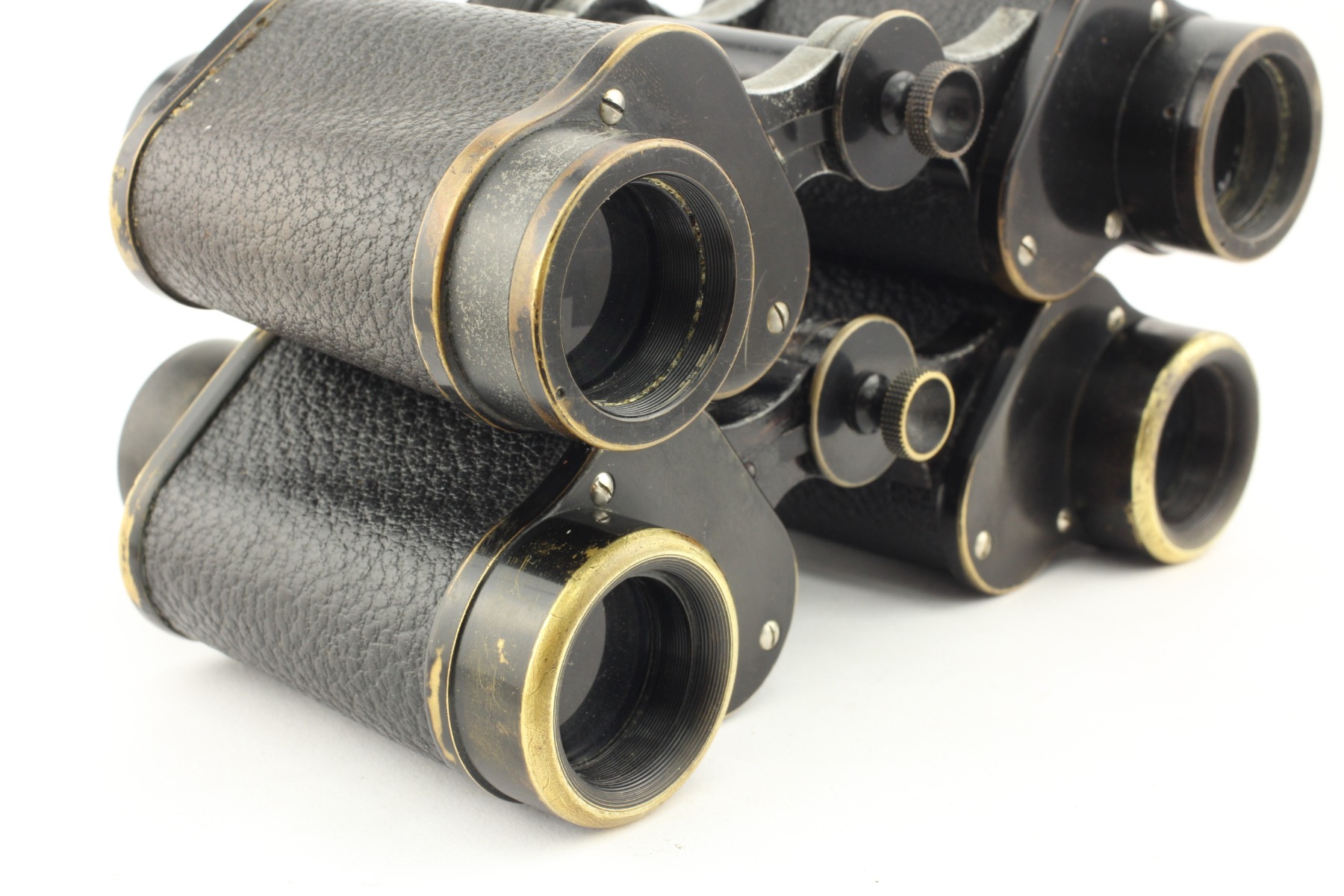Magnification: 8x
Aperture (objective diameter): 24 mm
Field of view: 6.6°
Visible field of view (eyepiece): 52,8°
Outlet pupil diameter: 3 mm
The closest focusing distance: 7 m
Width: 16 cm
Height: 12 cm
Weight: 660 g
Production date: 1913.
Binoculars Carl Zeiss Jena Telactem 8x (1)
Binoculars with central focusing appeared on the market in the middle of the 19th century. Carl Zeiss engineers were not in a hurry with such devices’ production, since they considered them less reliable and protected from dust and dirt. First prototypes of these binoculars were produced in Jena back in 1907, but only in 1909/1910 Carl Zeiss was forced to begin mass production of the devices of such design under the competitors’ pressure and because of the demand. First models of central-focus binoculars appeared in T136 catalog in 1910–those were Teletur 6x15, Telexem 6x21, Telactem 8x24 and Silvarem 6x30. Subsequently, all civilian Carl Zeiss binoculars with central focusing had an “...em” ending in their designations.
Telactem 8x binoculars were produced from 1909/1910 and up to 1914 in two versions: with the two-ring type lens frames (1909/1910-1913) https://binocollection.com/catalog/binoculars-carl-zeiss-jena-telactem-8x.html and with the rounded lens covers (1913-1914). As well as its split-focus analogue (namely, Telact 8x), this binocular is characterized by excellent optical characteristics among similar-level devices.




Telactem 8x binoculars were produced from 1909/1910 and up to 1914 in two versions: with the two-ring type lens frames (1909/1910-1913) https://binocollection.com/catalog/binoculars-carl-zeiss-jena-telactem-8x.html and with the rounded lens covers (1913-1914). As well as its split-focus analogue (namely, Telact 8x), this binocular is characterized by excellent optical characteristics among similar-level devices.
As well as its split-focus analogue (namely, Telact 8x), this binocular is characterized by excellent optical characteristics among similar-level devices.
The binocular “civilian” use is proved by the central focus mechanism (military models were never produced with it) and the central hinge clamp’s (fastener’s) small diameter (see photo), which has a hole for a knob (included to binoculars delivery kit). There is an interpupillary distance scale on the upper hinge disc. There is a diopter scale on the central focusing flywheel. The flywheel has a longitudinal notching (the previous version was produced with the transverse/perpendicular notching - see photo). The right eyepiece has its own focusing mechanism with a diopter scale.
The device under consideration belongs to the second, rather rare version with rounded lens caps and with the grooves, which help minimizing parasitic side flares. The eyepieces’ grooves (the knurling) are located along the binocular optical axis. The upper prism cover width is equal to 49 mm, the binocular height from lens frames’ lower cut to upper prismatic cover is equal to 79 mm. The prism covers are attached to the housing with the help of three screws. The eyepieces base diameter is equal to 24 mm. Compared to the previous version, the eyecups’ height has been slightly increased (from 11 to 13 mm) and their shape has been also changed a bit (see photo).
There are inscriptions “Carl Zeiss Jena” on the left prism cover. There is also an inscription “Telactem 360417 8x” on the right prism cover. The inscription is made in block letters on the background of Carl Zeiss Tessar photo lens schematic image.
This binocular’s coffer does not possess features peculiar to Carl Zeiss binocular coffers of that period, and, most likely, it has a different origin (the later one).
The serial number of this device is 360417; it was produced in 1913 as a 600 pieces batch.
The binocular with similar characteristics and with separate focusing, namely Telact 8x, is available by the following link: https://binocollection.com/catalog/binocular-carl-zeiss-jena-telact-8x-1.html
The binocular “civilian” use is proved by the central focus mechanism (military models were never produced with it) and the central hinge clamp’s (fastener’s) small diameter (see photo), which has a hole for a knob (included to binoculars delivery kit). There is an interpupillary distance scale on the upper hinge disc. There is a diopter scale on the central focusing flywheel. The flywheel has a longitudinal notching (the previous version was produced with the transverse/perpendicular notching - see photo). The right eyepiece has its own focusing mechanism with a diopter scale.
The device under consideration belongs to the second, rather rare version with rounded lens caps and with the grooves, which help minimizing parasitic side flares. The eyepieces’ grooves (the knurling) are located along the binocular optical axis. The upper prism cover width is equal to 49 mm, the binocular height from lens frames’ lower cut to upper prismatic cover is equal to 79 mm. The prism covers are attached to the housing with the help of three screws. The eyepieces base diameter is equal to 24 mm. Compared to the previous version, the eyecups’ height has been slightly increased (from 11 to 13 mm) and their shape has been also changed a bit (see photo).
There are inscriptions “Carl Zeiss Jena” on the left prism cover. There is also an inscription “Telactem 360417 8x” on the right prism cover. The inscription is made in block letters on the background of Carl Zeiss Tessar photo lens schematic image.
This binocular’s coffer does not possess features peculiar to Carl Zeiss binocular coffers of that period, and, most likely, it has a different origin (the later one).
The serial number of this device is 360417; it was produced in 1913 as a 600 pieces batch.
The binocular with similar characteristics and with separate focusing, namely Telact 8x, is available by the following link: https://binocollection.com/catalog/binocular-carl-zeiss-jena-telact-8x-1.html
